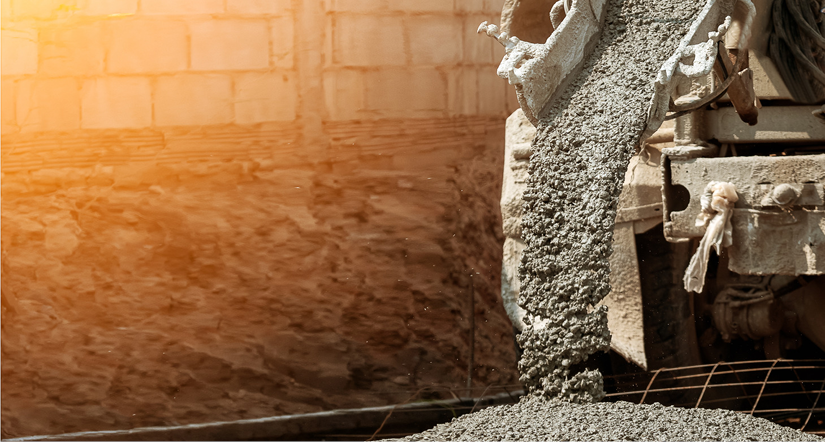By: Peter Waisanen, Senior Manager, Concrete Specialist | EXP
Concrete is a distinctive building material because its formulation is unique to its application. Compared to other building materials, designers and contractors have a greater influence on concrete formulation. Concrete can be made stronger, lighter, stiffer and less permeable depending on a project’s performance requirements. This versatility makes concrete an ideal material for a wide range of applications. With the ongoing innovations in concrete, its ecological footprint must be considered.
Earth’s natural resources continue to be consumed at a very high rate, and the construction industry is a heavy contributor. Potential resource depletion, CO2 emissions and high energy consumption rates in production increase the necessity of recycling. Concrete must be designed to provide a long service life with as little maintenance as possible, both of which will reduce the lifetime embodied carbon of the finished product. A term that relates to the metrics around measuring embodied carbon in this process is reduced global warming potential (GWP).
Changes have been incorporated into concrete production and are reducing the carbon footprint of this important material. These changes include:
- Using portland-limestone cement instead of pure portland cement can reduce the carbon footprint of cement by over 10%.
- Up to 80% of portland cement can be replaced with waste materials such as silica fume, slag cement and fly ash where project requirements allow.
- Using concrete containing finely ground recovered glass.
- Natural pozzolans, such as metakaolin, volcanic ash and rice husk ash, can reduce the amount of portland cement in concrete.
- Chemical admixtures can reduce the carbon footprint of concrete by lowering the water content of the concrete which requires less portland cement to attain the required strength.
- Using corrosion inhibitors in concrete can extend the time for reinforcing steel corrosion to be initiated and can extend the life of the elements exposed to chlorides.
- Admixtures that reduce the permeability of concrete are also used to slow the progression of chlorides through exterior concrete, thereby extending their life cycle.
- The use of shrinkage compensating admixtures reduces the potential for shrinkage cracking of concrete elements, and in applications where cracks would lead to early corrosion of embedded reinforcing steel, a reduction in cracks would extend the life expectancy of these elements. Using this admixture in concrete industrial floors reduces the number of joints needed, which also reduces maintenance needs.
- Companies can extract CO2 from waste streams and add it into concrete delivery trucks to improve the concrete. This added CO2 accelerates hydration and improves compressive strength, while also removing CO2 from the environment.
- Some specifications allow the use of concrete truck washout water in concrete mixes to save on potable water.
For projects where the ultimate strength of the concrete isn’t required early on, teams can specify concrete with a longer maturity date, such as 56 or even 91 days. This approach requires less portland cement to achieve the design strength. This applies to projects like new condo parking garages where the loadbearing columns will not carry their design loads for many months.
Large Canadian concrete suppliers have started producing mixes that can improve the carbon footprint of construction by reducing the CO2 in concrete by up to 90%. Companies throughout the world are also joining this effort.
As a primary construction material, there are concerns about concrete’s environmental impacts, and reusing readily available concrete is becoming very important. Considering that much of our infrastructure and urban buildings now require renovation and replacement, the concrete left behind can be a valuable aggregate source for new concrete. This type of concrete is usually referred to as recycled aggregate concrete. Cost analyses show that recycling concrete as aggregate for new concrete production can be a cost-effective construction method. These waste materials are already being used to replace virgin granular materials under roads and parking lots. Cement production is a significant source of greenhouse gas emissions. Experts are seeking more sustainable concrete mixes, as seen in Montreal’s Darwin Bridges Reconstruction project, which used finely ground recycled glass. Construction of the Darwin Bridges enabled the equivalent of 70,000 bottles to be recycled, saving 40,000 kg of cement. This construction technique prevented nearly 40 tons of CO2 from being released into the atmosphere.
The convergence of sustainability and durability in concrete will result in structures that will last longer and have a reduced carbon footprint. Recent changes in the availability and characteristics of cementitious material have sparked the need for new ways to use industrial by-products, new technologies to mitigate the carbon footprint, construction material recycling and challenging service life expectations in aggressive environments.
The American Concrete Institute has produced a new code, ACI CODE-323-24: Low-Carbon Concrete – Code Requirements and Commentary, which provides provisions for concrete where reduced GWP is required. The code was developed by a consensus process and addresses cast-in-place concrete with a specified compressive strength greater than 2500 psi and less than or equal to 8000 psi. Precast concrete, tremie concrete, auger-cast concrete/grout, shotcrete, pavers and masonry units are not included in the scope of the code.
CSA (Canadian Standards Association) has recently partnered with ANSI (American National Standards Institute, Inc.) to produce CSA/ANSI R118:24, CarbonStar: Concrete carbon intensity quantification and verification. The goal of this standard is to quantify the embodied carbon of concrete. This standard establishes a methodology for calculating both the carbon intensity of CO2-sequestering materials and using that data in a system that incorporates all relevant components to determine the embodied carbon of a unit of concrete. The purpose of the CarbonStar rating is to provide a transparent, replicable, auditable, scientifically sound and industry-accepted methodology for quantitatively assessing embodied carbon in concrete.
Learn more about EXP’s work in Earth + Environment.
Learn more about EXP’s sustainability work. Contact Peter to learn more about sustainable infrastructure solutions

